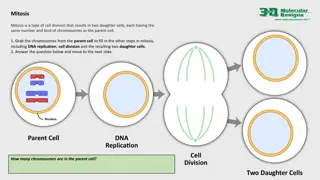Understanding Mitosis Through a Hands-On Modeling Activity
Explore the process of mitosis by engaging in a hands-on activity using gummy worms, toothpicks, and twizzlers to represent chromosomes, centromeres, and spindle fibers. Through a series of steps starting from Interphase, participants will replicate the stages of cell division, gaining a deeper understanding of how living things create new cells. Embrace the learning journey and scale your understanding as you describe and model the steps of mitosis.
Download Presentation

Please find below an Image/Link to download the presentation.
The content on the website is provided AS IS for your information and personal use only. It may not be sold, licensed, or shared on other websites without obtaining consent from the author. Download presentation by click this link. If you encounter any issues during the download, it is possible that the publisher has removed the file from their server.
E N D
Presentation Transcript
Modeling Mitosis How living things create new cells Cell Division Video Clip Learning Goal: SWBAT describe and model the steps of mitosis
Scale of Understanding Rate yourself on your level of understanding of mitosis- mark this on your sheet: 4-I can describe each phase of mitosis and create a model of each phase 3-I can describe each phase of mitosis 2-I can generally describe some of the changes the cell undergoes in mitosis 1-I can describe one change that occurs in the cell during mitosis 0-I cannot describe any changes in the cell during mitosis
Review 1. 2. 3. Mitosis is the process that ______ use to divide It contains a series of _________ or steps Cells created through mitosis are ________ to the parent cell New cells are called ________cells This process creates new _______ cells The cell makes a copy of its genetic information during_________________ (which phase)? 4. 5. 6.
Review 1. Mitosis is the process that cells use to divide 2. It contains a series of phases or steps 3. Cells created through mitosis are identical to the parent cell 4. New cells are called daughter cells 5. This process creates new body cells 6. The cell makes a copy of its genetic information during Interphase (which phase)?
Materials You will need: -gummy worms (6) -toothpicks (3) -twizzlers -cell templates -colored pencils Safety: Do not eat your chromosomes (gummy worms) until the end of lab. Keep your materials on your templates
Materials used in model Gummy worms will represent the chromosomes toothpicks will represent the centromeres Pull apart twizzlers will represent the spindle fibers
Interphase Description: DNA is copied, cell prepares for division DO: Lay your cell handouts on your table. Start off in the Parent Cell with one gummy worm of each color. Draw a colored picture in the first cell circle. Replicate each chromosome by laying the other chromosomes (gummy worms) next to the original chromosomes. Draw a colored picture in the second cell circle *Once the DNA is duplicated, the cell can go through a process called mitosis. This is the way a cell sorts and divides its genetic information in the nucleus.
Interphase Before DNA replication
Interphase After DNA replication
Prophase Description: membrane around the nucleus dissolves and the chromatin condenses into chromosomes. Chromosomes are held together by a centromere, a section of DNA The two copies of DNA are called sister chromatids With your group, discuss a way to model this phase using your materials
Prophase DO: Attach each sister chromatid to its copy using a bead and place them in the parent cell. Draw a picture on your lab sheet.
metaphase Description: Sister chromatids line up in center of cell, spindle fibers form to help separate the sister chromatids How could you model this phase?
metaphase DO: Take two strands of yarn and lay them down on opposite sides of the cell. Next, line up the sister chromatids end to end in the middle of the cell. Then, have one spindle fiber connect to each sister chromatid.
Anaphase Description: spindle fibers pull the sister chromatids apart and towards the side of the cell How could you model this phase?
Anaphase DO: Remove the centromere (beads) from your chromosomes and separate the sister chromatids so that one goes to the left side of the cell and the other goes to the right side. Repeat this for your other chromosomes and draw a picture
Telophase Description: Chromosomes are pulled to each side, cell begins to divide, new nuclei forms How could you model this? Hint: use the daughter cell side of your template
Telophase Description: The chromosomes reach the sides of the cell cell begins to divide membrane of a nucleus forms around each set of chromosomes-new nucleus for each daughter cell DO: Move the chromosomes onto the Daughter Cells handout to form two new cells called daughter cells. Draw a picture on your lab sheet
Wrap up Are the daughter cells identical to each other? Are the daughter cells identical to the parent cell? If your parent cell started off with 8 chromosomes, how many sister chromatids would be present during interphase (after replication)? How would I rate my level of understanding of mitosis after the lab? (circle one) 0, 1, 2, 3, 4 Which part of this activity helped you learn the most about mitosis?























